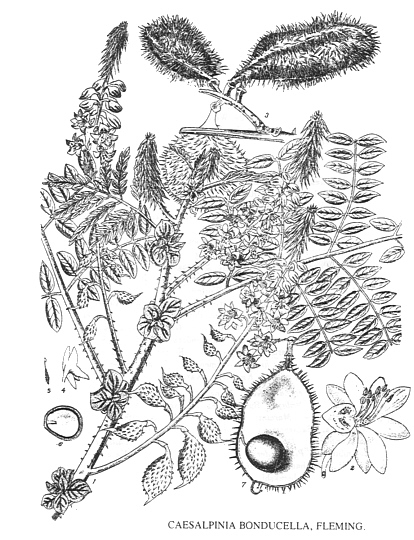

Zitierweise / cite as:
Carakasaṃhitā: Ausgewählte Texte aus der Carakasaṃhitā / übersetzt und erläutert von Alois Payer <1944 - >. -- Anhang A: Pflanzenbeschreibungen. -- Caesalpinia crista L. -- Fassung vom 2007-05-10. -- URL: http://www.payer.de/ayurveda/pflanzen/caesalpinia_crista.htm
Erstmals publiziert: 2007-03-19
Überarbeitungen: 2007-05-10 [Ergänzungen]
Anlass: Lehrveranstaltung SS 2007
©opyright: Dieser Text steht der Allgemeinheit zur Verfügung. Eine Verwertung in Publikationen, die über übliche Zitate hinausgeht, bedarf der ausdrücklichen Genehmigung des Verfassers
Dieser Text ist Teil der Abteilung Sanskrit von Tüpfli's Global Village Library
WARNUNG: dies ist der Versuch einer
Übersetzung und Interpretation eines altindischen Textes. Es ist keine
medizinische Anleitung. Vor dem Gebrauch aller hier genannten Heilmittel wird
darum ausdrücklich gewarnt. Nur ein erfahrener, gut ausgebildeter ayurvedischer
Arzt kann Verschreibungen und Behandlungen machen!
Falls Sie die diakritischen Zeichen nicht dargestellt bekommen, installieren Sie eine Schrift mit Diakritika wie z.B. Tahoma.
Verwendete und zitierte Werke siehe: http://www.payer.de/ayurveda/caraka0001.htm

Abb.: Caesalpinia crista L.
[Bildquelle: Kirtikar-Basu, ©1918]
Drury:
"Guilandina bonduc (Linn.) N. 0. Leguminosae. Kulunje, Caretti, Mal. Kalichikai, Tam. Getsakaia, Tel. Nata-caranja, Hind. Gutchka, Duk. Nata, Beng.
Description.—Climbing' shrub ; leaves abruptly bipinnated, more or less pubescent, 3-8 pair, with 1-2 small recurved prickles between them ; leaflets oval or ovate; prickles solitary; flowers yellow; sepals 5, nearly equal; petals 5, sessile; flowers largish, sulphur-coloured, spicately racemose; legume ovate, 2-valved, 1-2 seeded, covered with straight prickles ; seeds long, nearly globose. Fl. Aug.—Oct.—W. & A. Prod. i. 280.—G. bonducella, Linn.—Caesalpinia bonduc, Roxb. Fl. Ind. ii. 362.—Rheede, ii. t. 22.——Coromandel. Travancore. Bombay. Bengal.
Medical Uses.—The kernels of the nuts are very bitter, and said by the native doctors to be powerfully tonic. They are given in cases of intermittent fevers mixed with spices in the form of powder. Pounded and mixed with castor-oil, they are applied externally in hydrocele. At Amboyna the seeds are considered as anthelmintic, and the root tonic in dyspepsia. In Cochin China the leaves are reckoned as deobstruent and emmenagogue, and the root astringent. The oil from the former is useful in convulsions, palsy, and similar complaints. In Scotland, where they are frequently thrown upon the sea-shore, they are known as Molucca beans. Piddington has detected in the nuts, oil, starch, sugar, and resin.—Ainslie. Lour. Humph."
[Quelle: Drury, Heber <1819 - 1872>: The useful plants of India : with notices of their chief value in commerce, medicine, and the arts. -- 2d ed. with additions and corrections. London : Allen, 1873. -- xvi, 512 p. ; 22 cm. -- s.v.]